
5
Investment
In exploring the Hook Model, we discussed in chapter 2 the importance of aligning with the right internal triggers, and how by utilizing external triggers, designers can then prompt users with information for the next intended action.
In chapter 3 we learned about the role of the smallest actions taken in anticipation of immediate rewards. In chapter 4 we looked at how variable outcomes influence repeat engagement. There is one last step in the Hook Model that is critical for building habit-forming technologies. Before users create the mental associations that activate their automatic behaviors, they must first invest in the product.
Changing Attitude
In chapter 1 we learned about the tooth-flossing study in which researchers determined that the frequency of a new behavior is a leading factor in forming a new habit. The study also found that the second most important factor in habit formation is a change in the participant’s attitude about the behavior. The finding is consistent with the Habit Zone graph explained in the first chapter, which illustrates that for a behavior to become routine it must occur with significant frequency and perceived utility. Attitude change is the movement up the perceived utility axis until the behavior enters the Habit Zone.
But in order for a change in attitude to occur, there must be a change in how users perceive the behavior. In this chapter, we will start by exploring the mystery surrounding how small investments change our perception, turning unfamiliar actions into everyday habits.
A psychological phenomenon known as the escalation of commitment has been shown to make our brains do all sorts of funny things. The power of commitment makes some people play video games until they keel over and die. 1 It is used to influence people to give more to charity. 2 It has even been used to coerce prisoners of war into switching allegiances. 3 The commitments we make have a powerful effect on us and play an important role in the things we do, the products we buy, and the habits we form.
The more users invest time and effort into a product or service, the more they value it. In fact, there is ample evidence to suggest that our labor leads to love.
We Irrationally Value Our Efforts
In a 2011 study, Dan Ariely, Michael Norton, and Daniel Mochon measured the effect of labor on how people value things. 4
U. S. college students in America were given instructions to assemble an origami crane or frog. After the exercise students were asked to purchase their creation, bidding up to $1. Assemblers were informed that a random number between zero and one hundred was to be drawn. If it exceeded their reservation price in cents, the assemblers would return empty-handed—but if it was equal to or less than their bid, they would pay their bid and keep the origami. Meanwhile, a separate group of students located in another room, unaware of the identity of the assemblers, were asked to bid on their origami using the same procedure. Similarly, a third independent group was asked to bid on expert-made origami under the same criteria.
The results showed that those who made their own origami animals valued their creation five times higher than the second group’s valuation, and nearly as high as the expert-made origami values (figure 28 ). In other words, those who invested labor associated greater value with their paper creations simply because they had worked on them. Ariely calls this the IKEA effect.
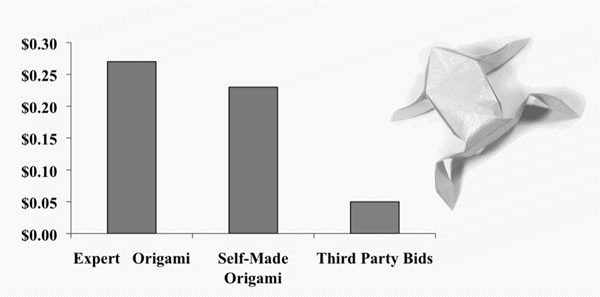
FIGURE 28
IKEA, the world’s largest furniture retailer, sells affordable, ready-to-assemble household furnishings. The Swedish company’s key innovation is its packaging process, which allows the company to decrease labor costs, increase distribution efficiency, and better utilize the real estate in its stores.
Unlike its competitors who sell preassembled merchandise, IKEA puts its customers to work. It turns out there’s a hidden benefit to making users invest physical effort in assembling the product—by asking customers to assemble their own furniture, Ariely believes they adopt an irrational love of the furniture they built, just like the test subjects did in the origami experiments. Businesses that leverage user effort confer higher value to their products simply because their users have put work into them. The users have invested in the products through their labor.
We Seek to Be Consistent with Our Past Behaviors
How much do past behaviors alter our future actions? We’d like to think we are free to choose to act in any way we’d like—that our judgment is not clouded by our past actions. But in fact, studies reveal that our past is an excellent predictor of our future.
A team of researchers asked a group of suburban residents to place large, unsightly signs in front of their homes that read DRIVE CAREFULLY . 5 Two groups were tested. In the first group only 17 percent of the subjects agreed to the request, while 76 percent of those in the second group agreed to post the ugly yard signs. What was the cause of this huge discrepancy? The groups were identical except for one factor.
Those in the second group were approached two weeks prior to the yard sign request and asked to place a much smaller, three-inch sign that read BE A SAFE DRIVER in their windows. Nearly everyone who was asked to place the smaller message agreed to this. When the researchers returned two weeks later, a whopping majority of these residents willingly replaced the small sign with the large one on their front lawns.
The homeowners’ greater willingness to place the large, obtrusive sign on their lawns after agreeing to the smaller one demonstrates the impact of our predilection for consistency with our past behaviors. Little investments, such as placing a tiny sign in a window, can lead to big changes in future behaviors.
We Avoid Cognitive Dissonance
In a classic Aesop’s fable, a hungry fox encounters grapes hanging from a vine. The fox desperately wants the grapes. Yet as hard as he tries, he cannot reach them. Frustrated, the fox decides the grapes must be sour and that therefore he would not want them anyway.
The fox comforts himself by changing his perception of the grapes because it is too uncomfortable to reconcile the thought that the grapes are sweet and ready for the taking, and yet he cannot have them. To reconcile these two conflicting ideas, the fox changes his perception of the grapes and in the process relieves the pain of what psychologists term cognitive dissonance .
The irrational manipulation of the way one sees the world is not limited to fictional animals in children’s stories. We humans do this as well.
Consider your reaction the first time you sipped a beer or tried spicy food. Was it tasty? Unlikely. Our bodies are designed to reject alcohol and capsaicin, the compound that creates the sensation of heat in spicy food. Our innate reaction to these acquired tastes is to reject them, yet we learn to like them through repeated exposure. We see others enjoying them, try a little more, and over time condition ourselves. To avoid the cognitive dissonance of not liking something that others seem to take so much pleasure in, we slowly change our perception of the thing we once did not enjoy.
Together, the three tendencies just described influence our future actions: The more effort we put into something, the more likely we are to value it; we are more likely to be consistent with our past behaviors; and finally, we change our preferences to avoid cognitive dissonance.
These tendencies of ours lead to a mental process known as rationalization , in which we change our attitudes and beliefs to adapt psychologically. Rationalization helps us give reasons for our behaviors, even when those reasons might have been designed by others.
At a 2010 industry conference, Jesse Schell, a renowned game designer and professor at Carnegie Mellon University, articulated the peculiar train of thought some players exhibit online. 6 Schell examined Mafia Wars , one of Zynga’s first breakout hits, which, like FarmVille , attracted millions of players.
“There’s definitely a lot of psychology here, because if someone had said, ‘Hey, we’re going to make a text-based mafia game that’s going to make over $100 million,’ you’d say, ‘I don’t think you’ll do that.’ Right?” Schell said, channeling the critics of the day who originally dismissed the free, primarily text-based online game. Yet Zynga used its understanding of human psychology to build an irresistible product at the time.
Mafia Wars was among the first games to utilize information about players’ Facebook friends. “It’s not just a virtual world anymore. It’s your real friends.” Schell said. “And you’re playing and it’s kind of cool … but then, hey, hey, my real friend is better than me. How can I remedy that? Well, I can play a long time or I could just put twenty dollars in—aha ! It’s even better if that twenty dollars I put in validates something I know is true, that I am greater than my college roommate, Steve.”
Schell went on, “Combine that with the psychological idea … of rationalization, that anything you spend time on, you start to believe, ‘This must be worthwhile. Why? Because I’ve spent time on it!’ And therefore it must be worth me kicking in twenty dollars because look at the time I’ve spent on it. And now that I’ve kicked in twenty dollars, it must be valuable because only an idiot would kick in twenty dollars if it wasn’t.”
Schell’s description of the quirky process of Mafia Wars rationalization helps demonstrate the strange logic of how we change our preferences. When players contemplate making a purchase, they acknowledge it is unwise to spend money on something that is not good. Yet just like the fox that perceives the grapes as sour to reduce his frustration at not being able to reach them, players justify their purchases to help convince themselves of something they want to be true—namely, that they are not foolish. The only solution is to keep paying to keep playing.
The cognitive changes that lead to behavior change help power the shift in how we view the products and services we use. But how are habit-forming products designed for user investment? How can a product keep users committed to a service until it becomes a habit?
Storing Value
Unlike physical goods in the real world, the software that runs our technology products can adapt itself to our needs. To become better with use, habit-forming technology utilizes investments users make in the product to enhance the experience.
The stored value users put into the product increases the likelihood they will use it again in the future and comes in a variety of forms.
Content
Every time users of Apple’s iTunes add a song to their collection, they are strengthening ties to the service. The songs on a playlist are an example of how content increases the value of a service. Neither iTunes nor their users created the songs, yet the more content users add, the more valuable the music library becomes (figure 29 ).
By aggregating content with one service, users can do more with their music and iTunes gets better with use by learning their preferences. With users’ continued investment, more songs also become accessible on multiple Apple devices. In 2013 Apple revealed that its new iTunes Radio service would provide personalized music recommendations based on the kind of music in users’ iTunes collections. The new feature provides yet another example of how technology adapts and improves based on users’ investment.
Content can also be created by a service’s users. For example, every status update, “like,” photo, or video shared on Facebook adds to the user’s timeline, retelling the story of one’s past experiences and relationships. As users continue to share and interact with information on the service, their digital life is recorded and archived.
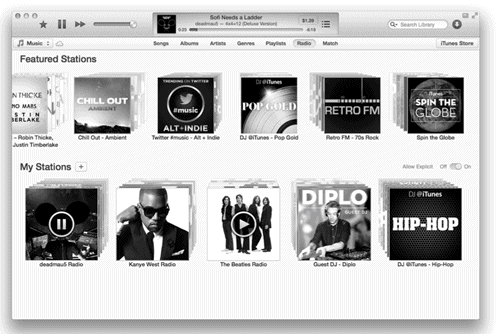
FIGURE 29
The collection of memories and experiences, in aggregate, becomes more valuable over time and the service becomes harder to leave as users’ personal investment in the site grows.
Data
Information generated, collected, or created by users (e.g., songs, photos, or news clippings) are examples of stored value in the form of content. Sometimes, though, users invest in a service by either actively or passively adding their own personal data.
On LinkedIn the user’s online résumé embodies the concept of data as stored value. Every time job seekers use the service, they are prompted to add more information.
The company found that the more information users invested in the site, the more committed they became to it.
As Josh Elman, an early senior product manager at the company, told me, “If we could get users to enter just a little information, they were much more likely to return.” The tiny bit of effort associated with providing more user data created a powerful hook to bring people back to the service.
Mint.com is an online personal finance tool used by millions of Americans. The service aggregates all of the user’s accounts in one place, providing a complete picture of their financial life—but only if they invest their time and data in the service. Mint provides multiple opportunities for users to customize the site and make it more valuable with use. For example, the act of linking accounts, categorizing transactions, or creating a budget are all forms of investment. The more data collected, the more the service’s stored value increases (figure 30 ).
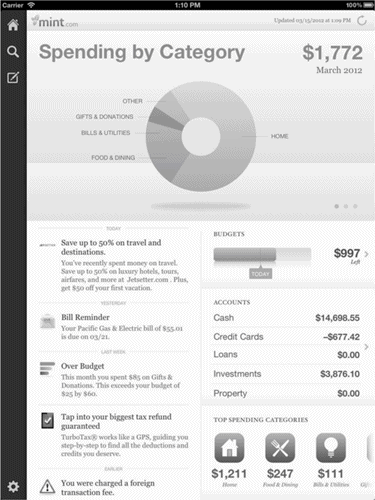
FIGURE 30
Followers
On the morning of Twitter’s initial public offering on November 7, 2013, a news commentator on Bloomberg Television said that “the technology needed to build the company could be built in a day.” 8 In fact, he was right. Twitter is a simple application. With a bit of basic programming know-how, anyone can build their very own clone of the multibillion-dollar social media behemoth.
In fact, several companies have tried to supplant the popular social network. One of the most notable attempts came from a disgruntled developer who decided to build App.net, an ad-free alternative that many tech industry watchers argue is actually a better product. However, like other attempts to copy the service, App.net has failed to take off. Why is this?
Collecting people to follow on Twitter, as well as collecting followers, provides tremendous value and is a key driver of what keeps Twitter users hooked (figure 31 ).
From the follower side of the equation, the more Twitter users curate the list of people they follow, the better the service will be at delivering interesting content.
Investing in following the right people increases the value of the product by displaying more relevant and interesting content in each user’s Twitter feed. It also tells Twitter a lot about its users, which in turn improves the service overall.
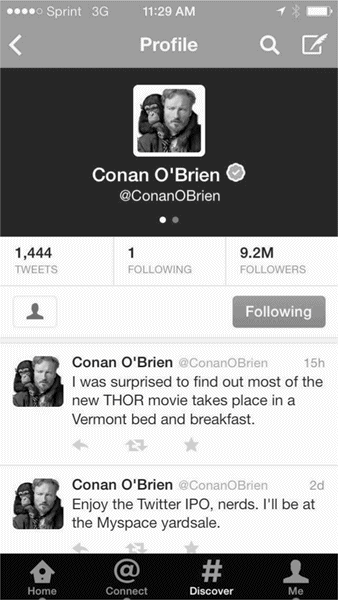
FIGURE 31
For the tweeter seeking followers, the more followers one has, the more valuable the service becomes as well. Content creators on Twitter seek to reach as large an audience as possible. The only way to legitimately acquire new followers is to send tweets others think are interesting enough to warrant following the sender. Therefore, to acquire more followers, content creators must invest in producing more—and better—tweets. The cycle increases the value of the service for both sides the more the service is used. For many users, switching services means abandoning years of investment and starting over. No one wants to rebuild a loyal following they have worked hard to acquire and nurture.
Reputation
Reputation is a form of stored value users can literally take to the bank. On online marketplaces such as eBay, TaskRabbit, Yelp, and Airbnb, people with negative scores are treated very differently from those with good reputations. It can often be the deciding factor in what price a seller gets for an item on eBay, who is selected for a TaskRabbit job, which restaurants appear at the top of Yelp search results, and the price of a room rental on Airbnb.
On eBay both buyers and sellers take their reputations very seriously. The e-commerce giant surfaces user-generated quality scores for every buyer and seller, and awards its most active users with badges to symbolize their trustworthiness. Businesses with bad reputations find it difficult, if not impossible, to compete against highly rated sellers. Reputation is a form of stored value that increases the likelihood of using a service.
Reputation makes users, both buyers and sellers, more likely to stick with whichever service they have invested their efforts in to maintain a high-quality score (figure 32 ).
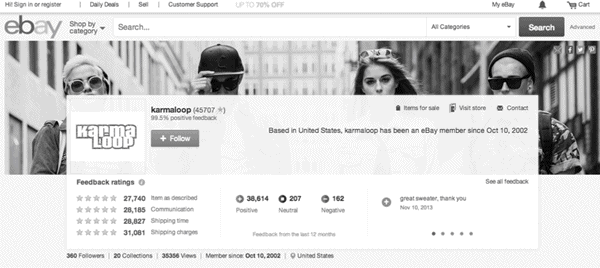
FIGURE 32
Skill
Investing time and effort into learning to use a product is a form of investment and stored value. Once a user has acquired a skill, using the service becomes easier and moves them to the right on the ability axis of the Fogg Behavior Model we discussed in chapter 3 . As Fogg describes it, non-routine is a factor of simplicity, and the more familiar a behavior is, the more likely the user is to do it.
For example, Adobe Photoshop is the most widely used professional graphics editing program in the world. The software provides hundreds of advanced features for creating and manipulating images. Learning the program is difficult at first, but as users become more familiar with the product—often investing hours watching tutorials and reading how-to guides—their expertise and efficiency using the product improves. They also achieve a sense of mastery (rewards of the self, as discussed in chapter 4 ). Unfortunately for the design professional, most of this acquired knowledge by users does not translate to competing applications.
Once users have invested the effort to acquire a skill, they are less likely to switch to a competing product.
Like every phase in the Hook Model, the investment phase requires careful use. It is not a carte blanche tool for asking users to do onerous tasks. In fact, quite the opposite. Just as in the action phase described in chapter 3 , to achieve the intended behavior in the investment phase, the product designer must consider whether users have sufficient motivation and ability to engage in the intended behavior. If users are not doing what the designer intended in the investment phase, the designer may be asking them to do too much. I recommend that you progressively stage the investment you want from users into small chunks of work, starting with small, easy tasks and building up to harder tasks during successive cycles through the Hook Model.
As we have just seen, users store value in the service during the investment phase. However, one other key opportunity found in the investment phase greatly increases the likelihood of users returning.
Loading the Next Trigger
As described in chapter 2 , triggers bring users back to the product. Ultimately, habit-forming products create a mental association with an internal trigger. Yet to create the habit, users must first use the product through multiple cycles of the Hook Model. Therefore, external triggers must be used to bring users back around again to start another cycle.
Habit-forming technologies leverage the user’s past behavior to initiate an external trigger in the future.
Users set future triggers during the investment phase, providing companies with an opportunity to reengage the user. We will now explore a few examples of how companies have helped load the next trigger during the investment phase.
1. Any.do
User retention is a challenge for any business, but especially for consumer mobile applications. According to a study by a mobile analytics firm, 26 percent of mobile apps in 2010 were downloaded and used only once. 9 Further data suggests people are using more applications but engaging with them less frequently. 10
Any.do is a simple mobile task-management app used to record to-do items such as picking up dry cleaning, restocking the fridge with milk, or calling Mom. Recognizing the challenge of retaining fickle mobile consumers, the app is designed to direct users to invest early on. During the first use of the app, Any.do elegantly teaches how to use the product (figure 33 ). The trigger comes in the form of the app’s clear, easy-to-follow instructions. The follow-up action is doing what the app tells the user to do. The variable rewards arrive in the form of a congratulatory message and the satisfaction of mastering the app.
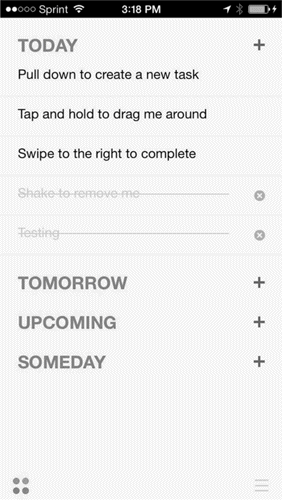
FIGURE 33
The investment comes next. Newcomers are instructed to connect the app to their calendar service, granting Any.do access to the user’s schedule. In doing so, users give the app permission to send a notification after the next scheduled meeting ends. This external trigger prompts users to return to the app to record a follow-up task from the meeting they just attended. In the Any.do scenario the app sends an external trigger to users at the moment when they are most likely to experience the internal trigger of anxiety about forgetting to do a task after a meeting. The Any.do app has anticipated a need and sets users up for success.
2. Tinder
In mid-2013 a hot new company entered the hypercompetitive online dating market. Tinder quickly captured the attention of millions of people looking for love with a simple interface, generating 3.5 million matches from 350 million swipes each day. 11
After launching the mobile app and logging in with Facebook, users browse profiles of other singles. Each potential match is presented as a card. Swipe left if you are not interested, right if that special someone catches your fancy (figure 34 ). If both parties express interest, a match is made and a private chat connects the two potential lovebirds.
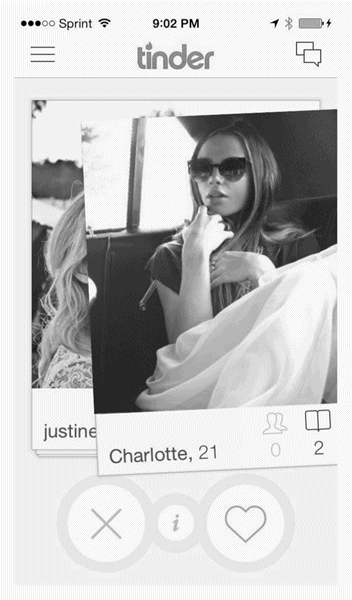
FIGURE 34
By simplifying the investment of sorting through potential mates, Tinder makes loading the next trigger more likely with each swipe. The more swipes, the more potential matches are made; naturally, each match sends notifications to both interested parties.
3. Snapchat
As of June 2013, Snapchat, a popular photo-sharing app, boasted of 5 million daily active users collectively sending over 200 million photos and videos daily. 12 This tremendous engagement means an average Snapchat user sends forty photos every day!
Why are users so in love with Snapchat? Its success can largely be attributed to the fact that users load the next trigger every time they use the service. Snapchat is more than a way to share images. It is a means of communication akin to sending a text message—with the added bonus of a built-in timer that can, based on the sender’s instructions, cause the message to self-destruct after viewing. Users pass through the investment phase of the Hook Model each time they send a selfie, doodle, or goofy photo. Each photo or video sent contains an implicit prompt to respond; the Snapchat interface makes returning a pic incredibly easy by twice tapping the original message to reply. The self-destruct feature encourages timely responses, leading to a back-and-forth relay that keeps people hooked into the service by loading the next trigger with each message sent.
4. Pinterest
Like many social networks, Pinterest loads the next trigger during the investment phase of the Hook. For many of the site’s 50 million monthly users, the online pin board replaced the habit of browsing fashion-focused Web sites—and before the web, flipping through magazines and dog-earing favorite pages. 13
The internal trigger for users is often boredom, for which the site offers a quick cure. Once registered, the only action required of users is to start scrolling as Pinterest showcases a wealth of variable rewards. First, because Pinterest is a socially curated collection of interesting items, the site displays a powerful intermittent reward surrounding the hunt for objects of desire, even if they are only images. The site also provides a means of communicating with friends and people who share similar tastes. The rewards of the tribe come from the variability of posting images as a communication medium. A user might be curious to know what a friend has pinned not only because of the image itself, but because of her relationship with the pinner.
Finally, Pinterest users invest in the site every time they pin an image of their own, repin someone else’s image, comment on, or like a piece of content on the site (figure 35 ). Each of these tiny investments gives Pinterest data it can use to tailor the site to each user’s individual taste; it also loads the next trigger. Each pin, repin, like, or comment gives Pinterest tacit permission to contact the user with a notification when someone else contributes to the thread, triggering the desire to visit the site again to learn more.
Pinterest clearly demonstrates the four stages of the Hook Model. It is a seamless flow: from the itch of the internal trigger that moves users to the intended action, through the variable reward, and finally to the investment, which also loads the next external trigger. Pinterest users move through the Hook cycle from beginning to end, then happily return to the starting point for another go-round.
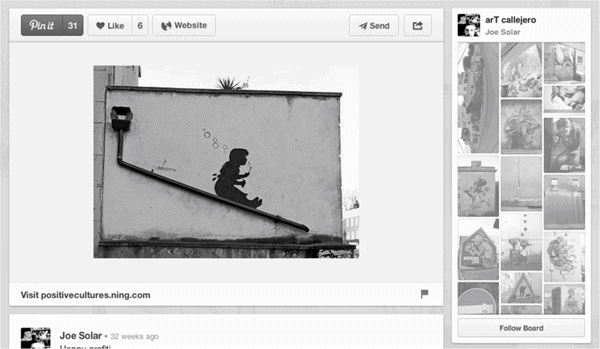
FIGURE 35
In this chapter we have learned how an investment in the product serves as the string that pulls the user back. To do this, the habit-forming technology increases the value of the product with each pass through the Hook. Through successive cycles of the Hook Model, users increase their affinity for the experience. They increasingly come to rely on the product as the solution to their problems until finally, the new habit—and routine—is formed.
The more users invest in a product through tiny bits of work, the more valuable the product becomes in their lives and the less they question its use. Users do not stay hooked forever, though. Invariably, the next big thing will come along and provide a better, more compelling hook. However, by creating habits fueled by investments in a product or service, companies make switching to a competitor difficult. User habits are hard to break and confer powerful competitive advantages to any company fortunate enough to successfully create them.